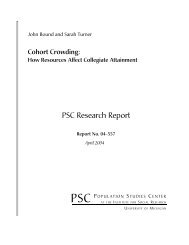Tracking metropolitan America into the 21st century - Population ...
Tracking metropolitan America into the 21st century - Population ...
Tracking metropolitan America into the 21st century - Population ...
Create successful ePaper yourself
Turn your PDF publications into a flip-book with our unique Google optimized e-Paper software.
Appendix B. Comparing Old and New Standards (continued)Old StandardsNew StandardsMerging Statistical AreasCentral Cities/PrincipalCitiesPrimary Metropolitan StatisticalAreas/MetropolitanDivisionsIf a county qualifies as a central county of one <strong>metropolitan</strong> statisticalarea and as an outlying county on <strong>the</strong> basis of commuting to a centralcounty of ano<strong>the</strong>r <strong>metropolitan</strong> statistical area, both counties becomecentral counties of a single <strong>metropolitan</strong> statistical area.Central cities include <strong>the</strong> largest city in a <strong>metropolitan</strong> statisticalarea/consolidated <strong>metropolitan</strong> statistical area AND each city of at least250,000 population or at least 100,000 workers AND each city of atleast 25,000 population and at least 75 jobs per 100 workers and lessthan 60% out commuting AND each city of at least 15,000 populationthat is at least 1/3 <strong>the</strong> size of largest central city and meets employmentratio and commuting percentage above AND <strong>the</strong> largest city of 15,000population or more that meets employment ratio and commuting percentageabove and is in a secondary noncontiguous urbanized areaAND each city in a secondary noncontiguous urbanized area that is atleast 1/3 <strong>the</strong> size of largest central city in that urbanized area and hasat least 15,000 population and meets employment ratio and commutingpercentage above.Primary <strong>metropolitan</strong> statistical areas outside New England consist ofone or more counties within <strong>metropolitan</strong> areas that have a total populationof 1 million or more. Specifically, <strong>the</strong>se primary <strong>metropolitan</strong> statisticalareas consist of: (A) One or more counties designated as astandard <strong>metropolitan</strong> statistical area on January 1, 1980, unless localopinion does not support continued separate designation.(B) One or more counties for which local opinion strongly supportsseparate designation, provided one county has: (1) at least 100,000population; (2) at least 60 percent of its population urban; (3) less than35 percent of its resident workers working outside <strong>the</strong> county; and (4)less than 2,500 population of <strong>the</strong> largest central city in <strong>the</strong> <strong>metropolitan</strong>statistical area.(C) A set of two or more contiguous counties for which local opinionstrongly supports separate designation, provided at least one countyalso could qualify as a primary <strong>metropolitan</strong> statistical area in section(B), and (1) each county meets requirements (B)(1), (B)(2), and (B)(4)and less than 50 percent of its resident workers work outside <strong>the</strong>county; (2) each county has a commuting interchange of at least 20percent with <strong>the</strong> o<strong>the</strong>r counties in <strong>the</strong> set; and (3) less than 35 percentof <strong>the</strong> resident workers of <strong>the</strong> set of counties work outside <strong>the</strong> area.Each county in <strong>the</strong> <strong>metropolitan</strong> area not included within a centralcore under sections (A) through (C), is assigned to <strong>the</strong> contiguous primary<strong>metropolitan</strong> statistical area to whose central core commuting isgreatest, provided this commuting is: (1) at least 15 percent of <strong>the</strong>county’ s resident workers; (2) at least 5 percentage points higher than<strong>the</strong> commuting flow to any o<strong>the</strong>r primary <strong>metropolitan</strong> statistical areacentral core that exceeds 15 percent; and(3) larger than <strong>the</strong> flow to <strong>the</strong> county containing <strong>the</strong> <strong>metropolitan</strong>area’s largest central city.Two adjacent CBSAs are merged to form one CBSA if <strong>the</strong> centralcounty/counties (as a group) of one CBSA qualify as outlying to <strong>the</strong>central county/counties (as a group) of <strong>the</strong> o<strong>the</strong>r.Principal cities include <strong>the</strong> largest incorporated place with a populationof 10,000 or more or, if no incorporated place of at least 10,000 is present,<strong>the</strong> largest incorporated place or census designated place in <strong>the</strong>CBSA AND each place of at least 250,000 population or in which atleast 100,000 persons work AND each place with a population of atleast 50,000, but less than 250,000 in which employment meets orexceeds <strong>the</strong> number of employed residents AND each place with a populationthat is at least 10,000 and 1/3 <strong>the</strong> size of <strong>the</strong> largest place, andin which employment meets or exceeds <strong>the</strong> number of employed residents.Metropolitan divisions consist of one or more counties within <strong>metropolitan</strong>statistical areas that have a single core of 2.5 million or more population.A county is identified as a main county of a <strong>metropolitan</strong> division if 65percent or more of its employed residents work within <strong>the</strong> county and<strong>the</strong> ratio of its employment to its number of employed residents is atleast .75.A county is identified as a secondary county of a <strong>metropolitan</strong> divisionif 50 percent or more, but less than 65 percent, of its employed residentswork within <strong>the</strong> county and <strong>the</strong> ratio of its employment to itsnumber of employed residents is at least .75 .A main county automatically serves as <strong>the</strong> basis for a <strong>metropolitan</strong> division.For a secondary county to qualify as <strong>the</strong> basis for forming a <strong>metropolitan</strong>division, it must join with ei<strong>the</strong>r a contiguous secondary countyor a contiguous main county with which it has <strong>the</strong> highest employmentinterchange measure of 15 or more.After all main counties and sceondary counties have been identifiedand grouped (if appropriate), each additional county that already hasqualified for <strong>the</strong> <strong>metropolitan</strong> statistical area is included in <strong>the</strong> metro-24November 2004 • The Brookings InstitutionThe Living Cities Census Series















